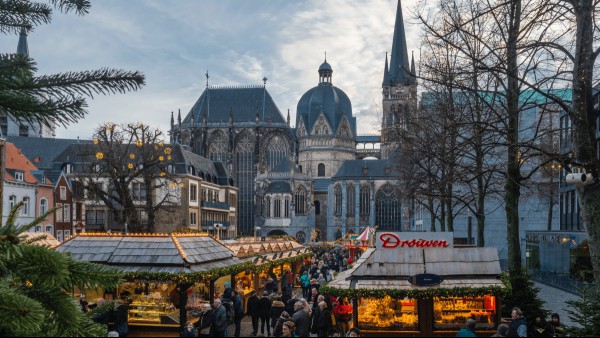Family Glossary: Defining The Different Ways We Live Together
A family can be many things. While there are certain “traditional” definitions of family — usually two parents and their children — the fact is that the concept of a nuclear family has always been limiting. A family can be one parent, three parents, a mixture of generations or even a group of people with no blood relations at all. It can differ from culture to culture, but even if you look at a single time and place, it’s unlikely every family will be organized the same way. In honor of International Family Day, Babbel’s linguistic experts put together a glossary that looks at a number of different types of family.
A Guide To All The Types Of Family
Without Children — For a variety of reasons, couples decide to not have children. A similar term, “child-free,” has been around since the early 20th century, but it caught on among feminists in the 1970s. It’s often used to distinguish people who voluntarily choose not to have children, with the suffix “free” showing a freedom from the societal obligation to take care of kids.
Heteroparental — This is one type of biparental family where the two parents are of opposite sex.

Homoparental — This is another type of biparental family where the parents are of the same sex. While this is not a new type of family, homoparental units have had to fight for their rights, especially in regard to raising children, in countries all around the world. It’s an ongoing battle in many places, as only 34 countries have legal same-sex marriage as of May 2023.
Polyparental — A polyparental family is one with more than two parents. Often, these come from polyamorous relationships, though there are not many places that recognize polygamous families. A polyparental unit doesn’t necessarily have to be polyamorous, either, as it can be any group of adults that is sharing the responsibilities of raising children.
Composite or Assembled — These two terms are used to describe a large number of possible family units, often caused by divorces or separation. A composite family will often be a mixture of blood relations and step-parent relationships. This is also not a particularly new kind of family, as exemplified by the 1960s sitcom The Brady Bunch, about a mother and father who merge their families together.

Single Parent or Monoparental — Perhaps self-explanatory, a single-parent family is one in which one adult takes care of the children. Single-parent families have become more common over the past few decades — often with the mother being the one parent — and there are any number of reasons for the arrangement.
Extended — An extended family refers to the relationships that go further than parent-child, including grandparents, aunts and uncles, cousins and whoever else is somewhat related by blood. Everyone has some form of extended family, though not everyone lives under a single roof with them.
Without Nucleus — While not a very common term, a “family without nucleus” refers to a group where there is no parent-child relationship. The children may live with an extended family member, for example. This phrase harkens back to the “nuclear family,” which is rigidly defined as only parents and their children.

Foster and Adoptive — A foster family is an adult or couple who cares for a child or group of children for a limited set of time. The child may later return to their biological parents, or be placed with a permanent adoptive family. As with many of these definitions, there are a number of different reasons a child may be placed with a foster family.
Of Origin — A family of origin is the group of people someone grew up with. For many, that might be their biological parents and siblings, but it can be pretty much any group that has helped shape how a person is raised.
Common-Law Marriages — Loosely, common-law marriages are those in which two people with or without children decide to forego traditional marriage and present as a married couple without the specific legal marriage certificate. The laws vary from place to place, so a common-law marriage can be treated as equal to other forms of marriage or be considered illegitimate by the government.
Multigenerational — A multigenerational family is one in which at least three generations — grandparents, parents and children, for example — live under a single roof. This arrangement is very common in certain countries, particularly those in Africa, Asia and Latin America, while in other places it’s rarer. The most usual case is that the younger generations care for the older ones.

Chosen — A chosen family is the network of support that is unrelated to blood ties. A chosen family is often formed by mutual interest and affection, and implies a certain form of reciprocal care. For many people, such as those who have been rejected by their biological family, a chosen family fulfills the same functions a biological family otherwise would.
RECOMMENDED NEWS

12 Famous Misquotes That People Get Wrong All The Time
We all love quoting famous people. Famous quotes are often pithy, sometimes hilarious and at times p...

Festive Traditions That Show There’s No Christmas Like German Christmas
Every country has its own holiday traditions, each of which are unique and wonderful in their own wa...

Are These 10 ‘French’ Things Actually French?
Americans really like French things. It’s pretty established. We like cooking French, dressing Frenc...

What Does It Mean To Be Bilingual?
Depending on where you live, bilingualism can be either the norm, a special talent certain people ha...

Farewell Elmer And Wilma: The Once-Popular U.S. Baby Names That Went Extinct
“What’s in a name?” as the famous Shakespeare quote goes. But naming trends can actually provide a f...

Which Are The Most Spoken Languages In The United Kingdom?
The United Kingdom is, unsurprisingly, very English. Of the 65.1 million residents of England, Scotl...
Comments on "Family Glossary: Defining The Different Ways We Live Together" :